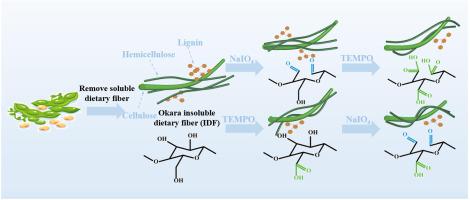不同高碘酸钠/TEMPO氧化顺序对卡拉不溶性膳食纤维结构和功能特性的影响
IF 11
1区 农林科学
Q1 CHEMISTRY, APPLIED
引用次数: 0
摘要
本文研究了NaIO4(高碘酸钠,O)和TEMPO(2,2,6,6-四甲基哌啶-1-氧基)不同氧化顺序的影响。T)研究了豆荚中不溶性膳食纤维(IDF)的结构和功能特性。采用NaIO4 (1:1 w/w, 6 h,深色)和TEMPO/NaBr/NaClO (15 mmoL, pH 10.5, 4 h)体系氧化IDF。结果表明,经过T氧化后,IDF的羧基含量显著提高,颗粒尺寸明显减小到纳米级。最小可达288.35±11.75 nm。改性IDF的热稳定性得到了显著改善,经t处理和共处理的样品均表现出独特的纤维结构。氧化顺序对样品表面官能团的影响很大,从而影响了样品的功能性质。具体来说,OT-IDF(由NaIO4-TEMPO氧化的IDF)表现出显著增强的持油能力和最佳的亚硝酸盐离子吸附能力,分别为IDF的143%和147%。然而,氧化过程中木质素的降解导致IDF的抗氧化能力显著下降,仅为IDF的33.1%。然而,氧化过程中木质素的降解导致IDF的抗氧化能力显著下降。综上所述,OT-IDF协同优化了IDF的功能特性,为okara的高价值利用提供了一条可行的途径。本文章由计算机程序翻译,如有差异,请以英文原文为准。

Effects of different sodium periodate/TEMPO oxidation sequences on the structural and functional properties of insoluble dietary fiber from okara
Herein, the effects of different oxidation sequences of NaIO4 (sodium periodate, O) and TEMPO (2,2,6,6-tetramethylpiperidine-1-oxyl radical,. T) on the structure and functional properties of insoluble dietary fiber (IDF) in okara were investigated. IDF was oxidized using NaIO4 (1:1 w/w, 6 h, dark) and TEMPO/NaBr/NaClO (15 mmoL, pH 10.5, 4 h) systems. The results show that after T oxidation, the IDF exhibits significantly higher carboxyl group content and a substantial reduction in particle size to the nanoscale. The smallest can reach 288.35 ± 11.75 nm. Significantly improved thermal stability was observed in the modified IDF, and both T-treated and T-co-treated samples exhibited unique fiber structures. The sequence of oxidation significantly influenced the surface functional groups of the samples, consequently affecting their functional properties. Specifically, OT-IDF (IDF oxidized by NaIO4-TEMPO) demonstrated a significantly enhanced oil-holding capacity and optimal nitrite ion adsorption capability, 143 % and 147 % of the IDF, respectively. However, the degradation of lignin during oxidation led to a significant decrease in the antioxidant capacity of the IDF, only 33.1 % of the IDF. However, the degradation of lignin during oxidation led to a significant decrease in the antioxidant capacity of the IDF. In conclusion, OT-IDF synergistically optimized the functional properties of IDF, offering a viable approach for the high-value utilization of okara.
求助全文
通过发布文献求助,成功后即可免费获取论文全文。
去求助
来源期刊

Food Hydrocolloids
工程技术-食品科技
CiteScore
19.90
自引率
14.00%
发文量
871
审稿时长
37 days
期刊介绍:
Food Hydrocolloids publishes original and innovative research focused on the characterization, functional properties, and applications of hydrocolloid materials used in food products. These hydrocolloids, defined as polysaccharides and proteins of commercial importance, are added to control aspects such as texture, stability, rheology, and sensory properties. The research's primary emphasis should be on the hydrocolloids themselves, with thorough descriptions of their source, nature, and physicochemical characteristics. Manuscripts are expected to clearly outline specific aims and objectives, include a fundamental discussion of research findings at the molecular level, and address the significance of the results. Studies on hydrocolloids in complex formulations should concentrate on their overall properties and mechanisms of action, while simple formulation development studies may not be considered for publication.
The main areas of interest are:
-Chemical and physicochemical characterisation
Thermal properties including glass transitions and conformational changes-
Rheological properties including viscosity, viscoelastic properties and gelation behaviour-
The influence on organoleptic properties-
Interfacial properties including stabilisation of dispersions, emulsions and foams-
Film forming properties with application to edible films and active packaging-
Encapsulation and controlled release of active compounds-
The influence on health including their role as dietary fibre-
Manipulation of hydrocolloid structure and functionality through chemical, biochemical and physical processes-
New hydrocolloids and hydrocolloid sources of commercial potential.
The Journal also publishes Review articles that provide an overview of the latest developments in topics of specific interest to researchers in this field of activity.
 求助内容:
求助内容: 应助结果提醒方式:
应助结果提醒方式:


